 |
 |





 |
 |
 |
 |
 |
 |
New I-35W/Crosstown plan increases capacity, requires fewer road closures
|
 |
 |
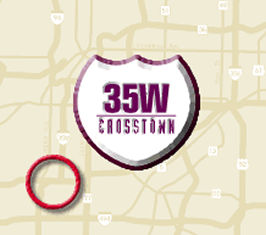 |
As required, Mn/DOT
delivered a new proposal for reconstructing the I-35W/Crosstown interchange
to the Legislature last week. More capacity, fewer roadway shutdowns—and
a larger price tag—are highlights of the new proposal.
|
More capacity and fewer roadway shutdowns are highlights of a new proposal
for reconstructing the I-35W/Crosstown interchange, Commissioner Elwyn Tinklenberg
announced Feb. 1 at a news conference at the Cedar Avenue Truck Station.
"This proposal more effectively balances the needs of the communities around
the project with the needs of the citizens who travel on the corridor each day.
It adds capacity, reduces construction delay and provides a significant advantage
for transit with the incorporation of an high occupancy vehicle lane," he said.
Last year, the Minnesota Legislature directed Mn/DOT to conduct the study and
return with the findings at the beginning of this year’s legislative session.
The new proposal is a recommendation from a consultant’s study delivered to
the Legislature last week.
The I-35W/Crosstown study began in August guided by an advisory committee of
state legislators and community leaders representing communities along the freeway
as well as commuters who travel through the interchange.
The proposal’s improved capacity comes from the addition of two full through
lanes on Hwy 62 instead of the originally proposed one through lane. I-35W will
have an additional lane north of the interchange. Mn/DOT is also pursuing the
addition of a high occupancy vehicle lane north of 46th Street into downtown
Minneapolis. This would provide for five lanes in each direction.
"This interstate carries more transit than any other corridor in the region,"
Tinklenberg said. "An HOV lane into downtown Minneapolis is critical to increasing
transit use. It provides an advantage to riding a bus that cannot be matched
by bus-only shoulder lanes."
Construction closures would run from two to eight weeks, compared to three
to four years under the original plan. The new proposal will require more right-of-way.
Preliminary estimates indicate the need to purchase another six to 12 homes.
The cost of the project would increase approximately 40 percent.
"This is clearly not a cost we had developed in our transportation investment
program," Tinklenberg said, explaining that to deliver the project, Mn/DOT will
need to find $80 million in new funding, or it will need to defer one or more
Metro area projects, or reduce the scope and cost of one or more Metro area
projects. He added that the situation is made more difficult by a preliminary
indication that there may be a dramatic reduction in federal funds available
to the state, as well as by significant inflationary increases in construction
costs.
"This issue highlights the need for increased long-term transportation funding,"
he said. "The Legislature has continued to under-fund transportation while demand
has grown. It’s time for the state to have a dedicated source of money for transportation
that will provide for these increasing needs."
For maps and more information, visit the I-35W/Crosstown
Web site.
By Kevin Gutknecht, Metro communications director
|
back

|
 |
Changes planned for EEO, Contract Management, Consultant Services offices
|
 |
 |
The Senior Management Team approved recommendations Feb. 5 to consolidate the
offices of Contract Management and Equal Employment Opportunity Contract Management
and to distribute the core functions of the Office of Consultant Services to
the districts, Metro Division, Office of Investment Management and Office of
Technical Support.
"Our next step is to develop an implementation plan for how this will
occur," said Dick Stehr, Program Support Group acting director and Mn/DOT’s
change management leader.
Stehr met with managers and staff of the affected offices on Tuesday and Wednesday
to talk about the changes, which are part of Mn/DOT’s Shaping
Our Future plan that envisions a distributed
products and services model for the organization.
"When instituting change, people make the difference," Stehr told
Program Support Group employees who packed the Central Office cafeteria Wednesday
afternoon. "No plan is perfect, but I have confidence that people like
you can make this change work."
Employees with questions about Mn/DOT’s Shaping Our Future efforts may send
them to change@dot.state.mn.us;
the Office of Communications and Public Relations will forward the questions
to the appropriate person for response. Stehr also encouraged employees to talk
to their managers and to visit the Shaping Our Future Web
site for links to a number of planning documents and Commissioner’s Office
memos.
|
back

|
 |
Legislative hearings begin on commuter rail project
|
 |
 |
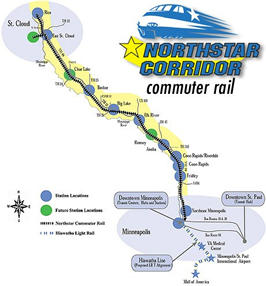 |
|
The proposed Northstar
Corridor Rail project would use existing tracks along an 82-mile corridor
from downtown Minneapolis to St. Cloud/Rice along Hwy 47 and Hwy 10. The
corridor is the fastest growing region in the state. Graphic from Northstar
Commuter Rail Web site
|
In the first legislative hearing on the governor’s commuter rail proposal,
Commissioner Elwyn Tinklenberg Feb. 4 urged lawmakers to approve a bonding bill
that would dedicate $120 million in state funds for the Northstar Corridor Rail
project.
"You’ve heard the phrase ‘We can’t build our way out of congestion.’ Let me
tell you we can’t hope our way out either," Tinklenberg said. "We do need to
build. What we need to build is an integrated managed transportation system
that creates attractive alternatives and is focused on the customer."
Tinklenberg added that a recent poll showed eight out of 10 people surveyed
along the corridor between Minneapolis and St. Cloud believe commuter rail is
a good idea.
Fastest growing corridor in the state
The proposed Northstar Corridor Rail project would use existing tracks along
an 82-mile corridor from downtown Minneapolis to St. Cloud/Rice along Hwy 47
and Hwy 10. The corridor is the fastest growing region in the state and one
of the fastest growing regions in the nation. Currently, more than 73,000 vehicles
travel parts of Hwy 10 every day. By 2025, traffic volumes are projected to
increase between 41 percent and 109 percent.
"Counties in the Northstar corridor are predicted to grow at double-digit rates
for the next two decades. Our roads alone cannot keep up with the increasing
travel demand that will result from this kind of growth," Tinklenberg said.
With 11 proposed stations, the Northstar line is expected to carry 9,600 passengers
per day when it begins operating in December 2005. Once downtown, passengers
will be able to transfer to buses and to the Hiawatha
Light Rail Transit line.
Federal funding at stake
Capital expenses for Northstar are estimated at $294 million. Funding would
be split $147 million federal, $120 million state and $27 million counties.
Tinklenberg noted the federal funding mechanism for Northstar requires state
matching funds.
"Minnesota is in line to receive $140 million in federal funds. But we will
only get federal money if the Legislature approves state funds." Tinklenberg
said. "Failure to act will mean that $147 million dollars will not come to Minnesota,
but instead go to one or more of two dozen other cities that are competing for
the funding."
Double-whammy
"Losing federal funding on Northstar could be a double whammy for the state
because it would come at the same time that Federal Highway Administration has
informed us that there may be a dramatic reduction in federal funds for highway
construction." Tinklenberg added the issue highlights the need for increased
long-term funding for transportation to ensure that Mn/DOT can meet future demands
on the state’s transportation system.
"I am convinced that commuter rail—when combined with a well-funded, long-term
road construction program—must be a part of the solution in this corridor and
others. We can make our state more secure, and protect our mobility and quality
of life," he said.
Several local groups also testified in favor of the Northstar project, including
cities and counties along the corridor, representatives of the American Legion,
the Minneapolis Downtown Council and senior citizens. More hearings are anticipated
later in the legislative session.
See also:
By Pat Lund
|
back

|
 |
Mn/DOT disputes claims by watershed district on Camp Coldwater pumping
|
 |
 |
Metro Division officials dispute findings announced by the Minnehaha Creek
Watershed District that the partly completed Hwy 55/ Hwy 62 interchange near
Fort Snelling significantly reduced the underground water flow that feeds the
historic Camp Coldwater spring.
Mn/DOT cancelled work on the interchange last fall until the dispute over the
effects of pumping—needed to allow construction of the interchange—is resolved.
Watershed officials said the pumping decreased the flow of water by 30 percent
last summer.
Bob Winter, acting Metro Division engineer, challenged the finding, noting
that testing from as far as 2.5 miles away showed the same fluctuations—suggesting
natural variations in flow and influences of other non-Mn/DOT projects.
All of those considerations, Winter said, make it impossible to say the interchange
construction is causing a change in flow to the spring.
Last year a consultant Mn/DOT hired and the district suggested building a concrete
barrier to divert water past the highway and its drainage system and send it
back toward the spring. The barrier, however, would add from $4 to $8 million
to the $16 million project.
"We are disappointed and at loss as to why the district would make this
assertion when all parties agreed that additional tests need to be done,"
Winter said. "Mn/DOT is committed to finding a design that all parties,
including the Department of Natural Resources, the watershed districts and the
Federal Highway Administration, can be comfortable with."
By Craig Wilkins
|
back

|
 |
St. Cloud’s buses get more ‘green time’ in intersections
|
 |
 |
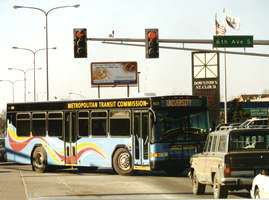 |
A St. Cloud Metropolitan
Transit Commission bus driver uses the transit priority system available
to buses on green lights to turn into an intersection on Division Street
in downtown St. Cloud. Photo by Dave Gonzalez
|
As they enter signalized intersections, St. Cloud’s transit buses will have
an advantage over other vehicles—an electronic system that extends the duration
of green lights and gives the buses extra time to get through the intersection
and stay on schedule.
The buses will be equipped with devices that send light wave signals to sensors
connected to traffic lights in the city’s busiest intersections such as those
along the Hwy 23 (Division Street) corridor. When completed in 2003, the system
will include a total of 89 intersections throughout the St. Cloud metro area.
Once activated, the traffic signals stay green for the buses for an additional
five to 15 seconds, giving them additional time to pass through or to turn.
The transit priority system allows drivers to operate at overall slower speeds,
increase time at the curb to assist passenger boarding, meet transfer points
on time more reliably and improve overall on-time performance, said Tom Cruikshank,
planning director for the St. Cloud Metropolitan Transit Commission.
The system’s 26 buses will use a version 3M’s Opticom system now used by the
city of St. Paul to clear intersections for emergency vehicles.
Creation of the system stems from an agreement by Mn/DOT and the MTC to determine
the system’s effectiveness as part of the department’s Intelligent Transportation
Systems research and development efforts. St. Cloud’s transit priority system
functions as a component of the St. Cloud Transportation Operations and Communications
Center.
Jim Kranig, Intelligent Transportation Systems director with the Office of
Traffic Engineering, said initial tests of the system showed many benefits for
transit system operation and that motorists reported no negative effects from
the system on their driving.
Cruikshank said the transit priority system underscores the TOCCs’ role of
integrating several transportation modes, including transit, in their operations.
By Craig Wilkins
|
back

|
 |
Computer model helps planners determine potential for archaeological sites
|
 |
 |
A new computer-generated model gives Mn/DOT added capability to better predict
the potential for encountering archeological sites when planning highway construction
projects.
Known as Mn/Model, the initiative gives Mn/DOT planners advance warning of
where sites are most likely to be found and helps speed construction by avoiding
delays that result when projects coincide with archeological site locations.
"Knowing where sites might be will both help preserve our cultural heritage
and streamline the process of planning and construction transportation projects,"
said Joe Hudak, Mn/Model project manager, Environmental Services. "We have
been required by federal regulation to identify significant cultural resources
since 1966. We expect this new method will be more accurate and reduce project
costs."
Geographical information system and cultural resource experts developed the
Mn/Model program to help avoid construction impacts to archeological sites throughout
Minnesota.
"For example," Hudak said, "in the Hwy 16 project in Hokah,
Mn/Model predicted a low potential for deeply buried archeological sites in
the project area near the Root River. Without Mn/Model, a separate study would
have been needed for the project on a very short schedule. Mn/Model helped us
avoid a delay in the project."
The project’s final report and other information appear on Mn/DOT’s Web site
at http://www.mnmodel.dot.state.mn.us/index.html.
|
back

|
 |
Delegation from former Soviet Union to visit Mn/DOT
|
 |
 |
Eighteen transportation experts from Russia, Ukraine, Tajikistan,
Kazakhstan, Armenia and Kyrgyzstan will visit Minnesota next week to spend three
days learning about Minnesota’s transportation system.
"The U.S. Commerce Department asked Minnesota to host the delegation because
of Mn/DOT’s reputation as a leader in technology and management practices,"
said Doug Weiszhaar, Mn/DOT deputy commissioner.
"We have more in common with former Soviet Union and Scandinavian countries
in terms of weather than we do with many U.S. states," said Weiszhaar, who visited
Siberia last year on behalf of Mn/DOT. "It makes sense to develop ties with
these countries so we can share information and develop new trade opportunities."
The international delegation, which arrives in the Twin Cities Feb. 11, will
tour Mn/DOT maintenance facilities and the Mn/ROAD test site near Monticello,
as well as the Caterpillar plant in Brooklyn Park and the 3M facilities in St.
Paul.
The visit is just the latest information exchange between Mn/DOT and countries
that share Minnesota’s climate. Mn/DOT recently formalized relationships with
transportation agencies in Sweden, Finland and Norway. These partnerships enable
the department to exchange improved techniques in anti-icing practices, road
construction and maintenance, and traveler information.
By Pat Lund
|
back

|
 |
Three appointed to management positions in Metro Division
|
 |
 |
Bob Winter, Keith Shannon and Khani Sahebjam have taken on new management roles
in Mn/DOT.
As of Jan. 2, Winter has assumed the responsibilities of acting Metro Division
engineer for Dick Stehr while Stehr is on reassignment as acting director of
the Program Support Group. Previously, Winter was Metro’s assistant division
engineer.
He also has served in key management positions for light rail transit, rail
transit and multi-modal projects and the reconstruction of I-35E and I-94. He
has more than 30 years experience with Mn/DOT.
Shannon is the acting assistant division engineer. During his 23 years with
Mn/DOT, Shannon has held a number of positions, including serving as Program
Delivery director in Metro, assistant state bridge engineer and Metro maintenance
operations engineer.
Now acting Program Delivery office director, Sahebjam has worked for Mn/DOT
for 12 years. Previously, he was the assistant state bridge engineer.
Sahebjam also has had managerial and professional experience in State Aid,
the Office of Research Administration and the Office of Bridges and Structures.
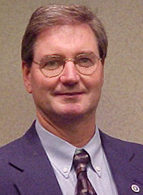 |
|
Keith Shannon
|
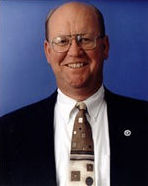 |
|
Bob Winter
|
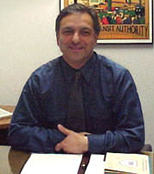 |
|
Khani Sahebjam
|
|
back

|
 |
In the mail
|
 |
 |
In 1961 when I moved to Silver Bay, traveling to Duluth was an "adventure"
and a not very safe one at that! The improvements to Hwy 61 in the past 41 years
have made today's trips to Duluth a VERY PLEASANT experience. I'm writing to
simply thank Mn/DOT for the improvements to the quality of HWY 61! THANK YOU!!
Most sincerely,
Jim Linscheid, Silver Bay
|
back

|
|
 |
|



